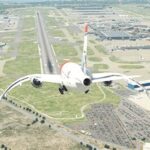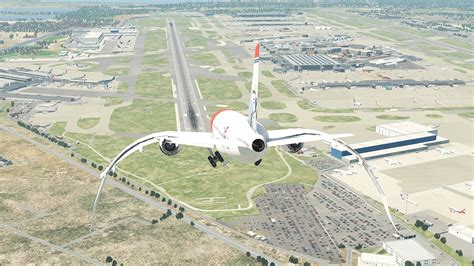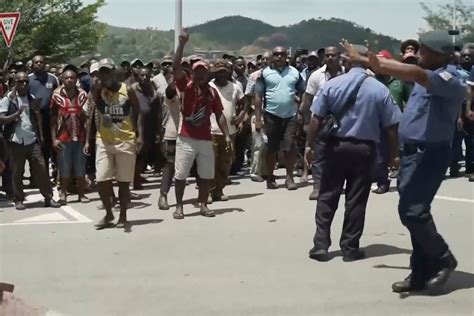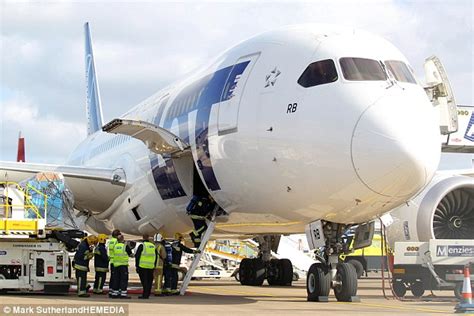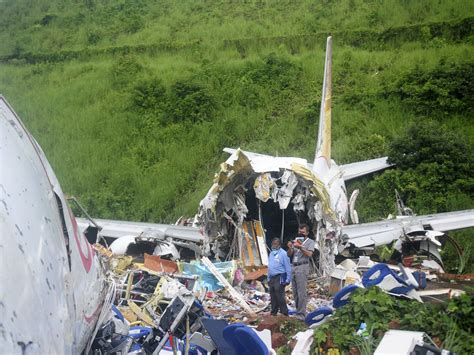
A survivor of the Air India Express crash in Kerala, India, is recounting his harrowing experience from his hospital bed, describing the chaotic scene and his miraculous escape from the wreckage.
Riyas, a 24-year-old man, told news outlets that he feels as though he has been given a new life after surviving the Air India Express flight IX-1344 crash at the Kozhikode airport on Friday. He described the aircraft splitting in two upon impact after overshooting the runway during heavy rainfall. “This is a second life. When I opened my eyes, I saw the plane broken in two. I don’t know what happened,” Riyas stated from his hospital bed, grappling with the shock of the incident that claimed the lives of at least 18 people, including both pilots, and injured over 150 others.
The Air India Express flight, en route from Dubai, was attempting to land at the Kozhikode airport amidst challenging weather conditions when the incident occurred. The Boeing 737-800 aircraft overshot the runway, plunging into a valley and breaking into two sections. Initial reports suggest that heavy rain and poor visibility played a significant role in the accident. The Directorate General of Civil Aviation (DGCA) has launched a formal investigation to determine the exact cause of the crash.
Riyas recounted the moments leading up to the crash, stating that the flight had already circled the airport twice due to the inclement weather. He was seated in the back of the plane and remembers a sudden, violent impact. “The plane circled twice, and then it went for landing. Then suddenly there was a jerk, and everything went blank,” he said. When he regained consciousness, he was surrounded by debris and injured passengers. He managed to extricate himself from the wreckage and was subsequently rescued by emergency responders.
The crash site was a scene of chaos as rescue workers battled torrential rain to pull survivors from the wreckage. Local residents also rushed to the scene to assist in the rescue efforts. Ambulances transported the injured to various hospitals in Kozhikode and Malappuram districts. Authorities have praised the swift response of the emergency services and the local community in providing aid to the victims.
The Air India Express flight IX-1344 had 190 people on board, including 184 passengers, two pilots, and four cabin crew members. Among the passengers were several infants and children. The black box, which contains the cockpit voice recorder and flight data recorder, has been recovered from the crash site and will be crucial in the investigation process. Investigators will analyze the data to understand the sequence of events that led to the crash.
The Kozhikode airport, also known as Calicut International Airport, has a tabletop runway, which poses unique challenges for landing, especially during adverse weather conditions. A tabletop runway is constructed on a hill or elevated terrain, with steep drops at one or both ends. While such runways are generally safe, they require precise approaches and landings. Pilots need to be particularly vigilant to avoid overshooting the runway, as happened in this incident.
Aviation experts are examining various factors that may have contributed to the crash, including weather conditions, pilot error, and mechanical failure. The investigation will also focus on the airport’s safety protocols and the training of the pilots. The findings of the investigation are expected to be released in the coming weeks.
The Air India Express is a low-cost subsidiary of Air India, operating primarily on routes connecting India with the Middle East and Southeast Asia. The airline has a generally good safety record, with only a few minor incidents in its history. This crash is the most serious incident involving Air India Express since the 2010 crash in Mangalore, where 158 people lost their lives.
The Indian government has announced compensation for the families of the deceased and the injured. The Prime Minister has expressed his condolences to the bereaved families and has assured them of all possible assistance. The Ministry of Civil Aviation is coordinating the rescue and relief efforts, working closely with the state government of Kerala.
The crash has raised concerns about the safety of air travel in India, particularly during the monsoon season. The DGCA has ordered a review of safety procedures at all airports in the country and has instructed airlines to take extra precautions while operating in adverse weather conditions. The incident has also sparked a debate about the suitability of tabletop runways for large aircraft.
Riyas, like many other survivors, is now grappling with the physical and emotional trauma of the crash. He expressed gratitude for being alive but also mourned the loss of lives and the suffering of others. He hopes that the investigation will uncover the truth about what happened and that measures will be taken to prevent similar tragedies in the future.
The incident has brought the aviation community together in solidarity. Airlines and aviation organizations around the world have expressed their condolences and offered assistance to Air India Express and the Indian government. The focus now is on providing support to the victims and their families and ensuring that lessons are learned from this tragic event.
The recovery process for the survivors will be long and challenging. Many of them have sustained serious injuries and will require extensive medical treatment and rehabilitation. They will also need psychological support to cope with the trauma of the crash. The government and various NGOs are providing counseling services to the survivors and their families.
The Air India Express crash at Kozhikode airport is a stark reminder of the inherent risks of air travel. While aviation is generally considered to be a safe mode of transportation, accidents can and do happen. It is crucial that all stakeholders, including airlines, airports, and regulatory authorities, work together to ensure the highest standards of safety and to minimize the risk of future accidents.
The investigation into the crash is ongoing, and it is likely to take several months to complete. The investigators will examine all aspects of the incident, from the weather conditions at the time of the crash to the maintenance records of the aircraft. They will also interview the pilots, air traffic controllers, and other relevant personnel. The findings of the investigation will be used to improve safety procedures and to prevent similar accidents in the future.
The Air India Express crash has had a profound impact on the aviation industry and on the people of India. It is a tragedy that will not be forgotten. The memories of the victims will live on, and their stories will serve as a reminder of the importance of safety in air travel.
Expanded Context and Analysis
The Air India Express IX-1344 crash at Kozhikode airport highlights several critical issues within the aviation industry, particularly concerning operations in challenging environments and the safety of tabletop runways. Examining the factors that potentially contributed to the accident can offer a deeper understanding of the complexities involved and inform future preventative measures.
Weather Conditions and Pilot Experience:
The primary factor cited immediately following the crash was the adverse weather. Kozhikode, like many parts of Kerala, experiences heavy rainfall during the monsoon season. This leads to reduced visibility and increased risk of hydroplaning, where a layer of water separates the aircraft tires from the runway surface, reducing braking effectiveness. Riyas’s account of the plane circling twice before attempting landing suggests that the pilots were already assessing the unfavorable conditions.
Pilot experience in such conditions is paramount. While the investigation will reveal the specifics of the pilots’ qualifications and training, it’s worth noting that landing on a wet runway requires a high degree of precision and judgment. The pilots must accurately assess the available runway length and adjust their approach speed and braking accordingly. Any miscalculation can lead to an overshoot.
Tabletop Runway Challenges:
Kozhikode airport’s tabletop runway design presents unique challenges. These runways, often built on elevated terrain, have limited overrun space, meaning that if an aircraft overshoots the runway, there is a high risk of it plunging into a valley or other obstacle. While tabletop runways are not inherently unsafe, they require stringent safety protocols and meticulous adherence to procedures.
The DGCA and airport authorities typically implement measures to mitigate the risks associated with tabletop runways. These include:
- Reduced Landing Weights: Limiting the maximum takeoff and landing weights of aircraft operating at these airports.
- Enhanced Braking Systems: Ensuring that aircraft operating at these airports are equipped with advanced braking systems.
- Runway End Safety Areas (RESAs): Providing a buffer zone at the end of the runway to allow aircraft to stop safely in case of an overshoot.
- Regular Inspections and Audits: Conducting regular inspections and audits of the airport’s safety procedures.
- Pilot Training: Providing pilots with specialized training on landing on tabletop runways.
Whether these measures were fully effective at Kozhikode airport will be a key focus of the investigation. The presence and adequacy of the Runway End Safety Area (RESA) will be examined in detail, as will the airport’s compliance with international safety standards.
Aircraft Maintenance and Technical Factors:
While the initial focus has been on weather and runway conditions, the investigation will also consider potential mechanical or technical factors that may have contributed to the crash. The aircraft’s maintenance records will be scrutinized for any anomalies or recurring issues. The performance of the aircraft’s engines, braking systems, and other critical components will be assessed. The recovery of the black box is critical to understanding these aspects. The flight data recorder (FDR) will provide a detailed record of the aircraft’s speed, altitude, and other parameters, while the cockpit voice recorder (CVR) will capture the communications between the pilots and air traffic control.
Human Factors and Crew Resource Management (CRM):
The investigation will also delve into human factors and crew resource management (CRM). CRM refers to the effective use of all available resources – human, hardware, and information – by a flight crew to ensure a safe and efficient operation. This includes communication, decision-making, leadership, and teamwork.
The CVR will provide valuable insights into the pilots’ decision-making process in the moments leading up to the crash. Investigators will analyze whether the pilots effectively communicated with each other, whether they considered all available options, and whether they made the best possible decisions given the circumstances. They will also look at factors such as fatigue, stress, and workload, which can all impact pilot performance.
Regulatory Oversight and Safety Culture:
The Air India Express crash also raises questions about regulatory oversight and safety culture within the airline and the broader Indian aviation industry. The DGCA is responsible for ensuring that airlines and airports comply with safety regulations and standards. The investigation will assess whether the DGCA effectively monitored Air India Express’s operations and whether the airline had a strong safety culture.
A strong safety culture is one in which safety is prioritized at all levels of the organization, from senior management to frontline employees. It involves open communication, a willingness to report errors and near misses, and a commitment to continuous improvement. The investigation will determine whether Air India Express had a robust safety culture and whether its employees felt empowered to raise safety concerns.
Compensation and Support for Victims:
The Indian government’s announcement of compensation for the victims and their families is a welcome step. However, financial compensation is only one aspect of the support that is needed. Many of the survivors will require long-term medical care, rehabilitation, and psychological support. The government and NGOs should work together to provide comprehensive support to the victims and their families. This includes providing counseling services, financial assistance, and legal aid.
Long-Term Impact on Air Travel:
The Air India Express crash is likely to have a long-term impact on air travel in India. Passengers may be more hesitant to fly, particularly during the monsoon season. Airlines may be forced to increase their fares to cover the costs of enhanced safety measures. The DGCA may implement stricter regulations, which could lead to delays and increased bureaucracy.
The aviation industry must learn from this tragedy and take steps to prevent similar accidents in the future. This includes investing in advanced technology, improving pilot training, strengthening regulatory oversight, and fostering a strong safety culture. By doing so, the industry can restore public confidence and ensure that air travel remains a safe and reliable mode of transportation.
The Survivor’s Perspective:
Riyas’s story offers a poignant reminder of the human cost of aviation accidents. His miraculous survival and his account of the chaotic scene provide a valuable perspective on the experience of being involved in a crash. His hope that the investigation will uncover the truth and prevent future tragedies is shared by many. His words also serve as a reminder of the resilience of the human spirit and the importance of providing support to those who have been affected by such events.
Conclusion:
The Air India Express crash at Kozhikode airport was a complex event with multiple contributing factors. The investigation is likely to take several months to complete, but its findings will be crucial for improving safety in the aviation industry. The crash highlights the importance of weather conditions, tabletop runway challenges, aircraft maintenance, human factors, regulatory oversight, and safety culture. By addressing these issues, the aviation industry can work to prevent similar tragedies in the future and ensure the safety of air travel for all.
Frequently Asked Questions (FAQ)
-
What caused the Air India Express crash at Kozhikode airport? The precise cause is still under investigation, but initial reports suggest that heavy rain and poor visibility contributed to the accident. The aircraft overshot the runway, plunged into a valley, and broke into two sections. Weather conditions, the challenges associated with the tabletop runway, and potential mechanical or human factors are all being examined. The black box data will be crucial in determining the definitive cause.
-
What is a tabletop runway, and why is it considered more challenging? A tabletop runway is built on a hill or elevated terrain, often with steep drops at one or both ends. This design reduces the margin for error during landing, as there is limited overrun space if an aircraft overshoots the runway. Precise approaches and landings are essential on tabletop runways, especially in adverse weather conditions.
-
What measures are being taken to support the survivors and families of the victims? The Indian government has announced compensation for the families of the deceased and the injured. Additionally, various hospitals in Kozhikode and Malappuram districts are providing medical treatment to the injured. Counseling services are being offered to the survivors and their families to help them cope with the trauma. NGOs are also providing assistance with rehabilitation and other support services.
-
What is the role of the Directorate General of Civil Aviation (DGCA) in this investigation? The DGCA is the regulatory authority responsible for aviation safety in India. They have launched a formal investigation into the Air India Express crash to determine the exact cause. The DGCA will analyze the black box data, examine the aircraft’s maintenance records, interview pilots and air traffic controllers, and assess the airport’s safety procedures. The findings of the investigation will be used to improve safety procedures and prevent similar accidents in the future.
-
What steps can be taken to prevent similar accidents from happening in the future? Several steps can be taken, including: enhancing pilot training, particularly for landing in adverse weather conditions and on tabletop runways; improving weather forecasting and communication to pilots; ensuring that airports have adequate safety measures in place, such as Runway End Safety Areas (RESAs); strengthening regulatory oversight of airlines and airports; fostering a strong safety culture within the aviation industry; and investing in advanced technology to improve aircraft safety. A thorough review of existing safety protocols and their strict implementation are also critical.
